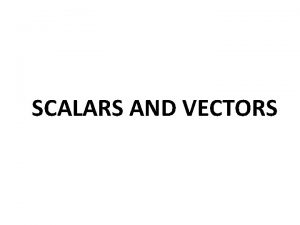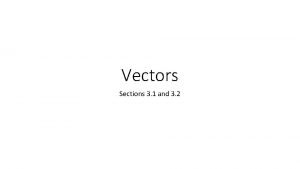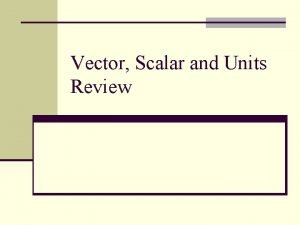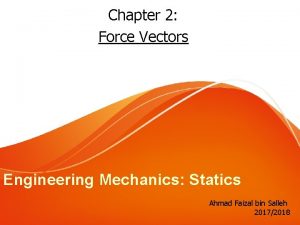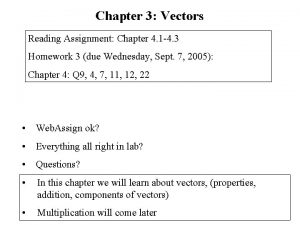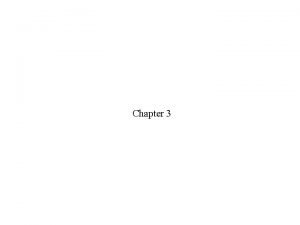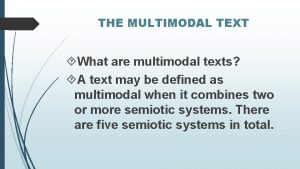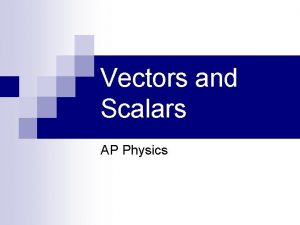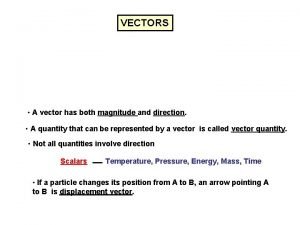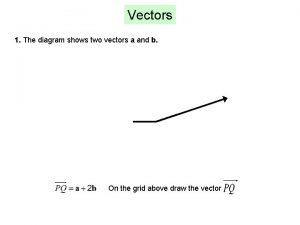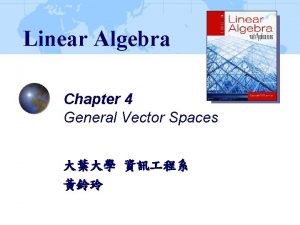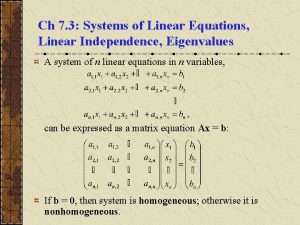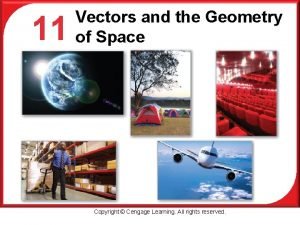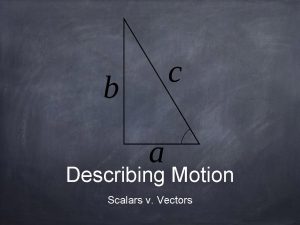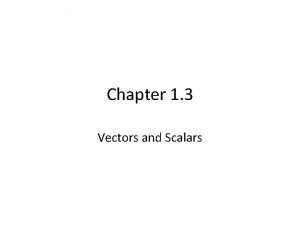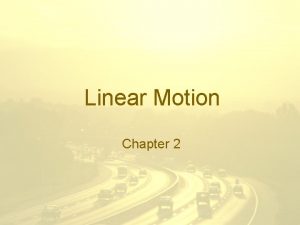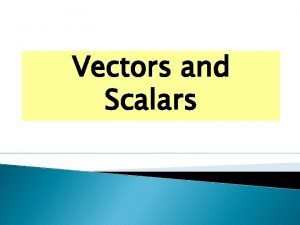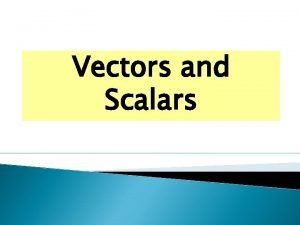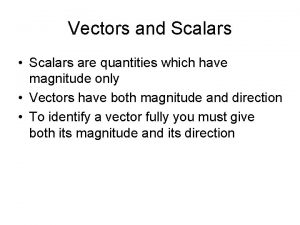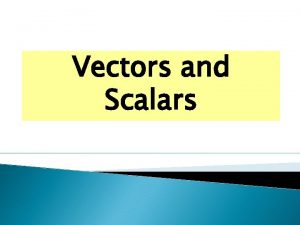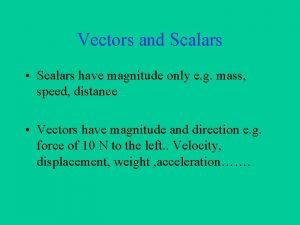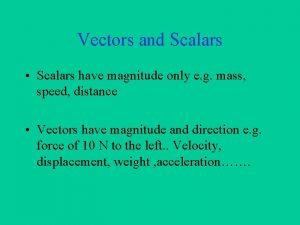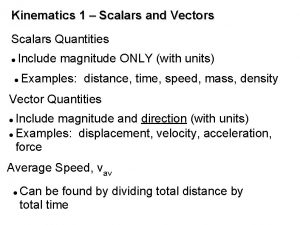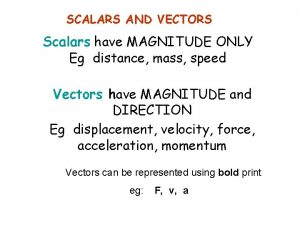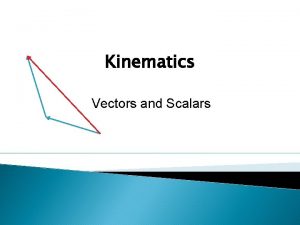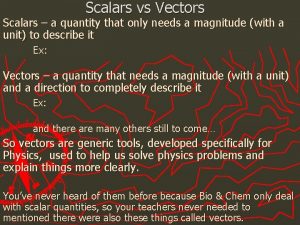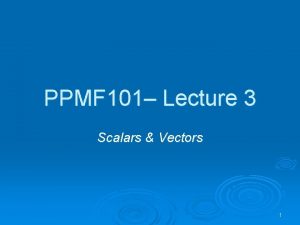Vectors Chapter 4 Vectors and Scalars What is






















- Slides: 22

Vectors Chapter 4

Vectors and Scalars • What is a vector? – A vector is a quantity that has both magnitude (size, quantity, value, etc. ) and direction. • What is a scalar? – A quantity that has only magnitude.

Vector vs. Scalar • Vectors – Displacement (d) – Velocity (v) – Weight / Force (F) – Acceleration (a) • Scalars – Distance (d) – Speed (v) – Mass (m) – Time (t) Note: Vectors are normally represented in bold face while scalars are not.

Vector vs. Scalar 770 m 270 m 670 m 868 m d. Total = 1, 710 m d = 868 m NE The resultant will always be less than or equal to the scalar value.

Representing Vectors Graphically • Two vectors are considered equal if they have the same magnitude and direction. • If the magnitude and/or direction are different, then the vectors are not considered equal. A=B A A B B A≠B

Adding & Subtracting Vectors • Vectors can be added or subtracted from each • • other graphically. Each vector is represented by an arrow with a length that is proportional to the magnitude of the vector. Each vector has a direction associated with it. When two or more vectors are added or subtracted, the answer is called the resultant. A resultant that is equal in magnitude and opposite in direction is also known as an equilibrant.

Adding & Subtracting Vectors If the vectors occur in a single dimension, just add or subtract them. 4 m + 7 m 3 m = 7 m 7 m • When adding vectors, place the tail of the second vector at the tip of the first vector. • When subtracting vectors, invert the second one before placing its tail at the tip of the first vector.

Adding Vectors using the Pythagorean Theorem If the vectors occur such that they are perpendicular to one another, the Pythagorean theorem may be used to determine the resultant. 5 m 4 m + 3 m A 2 + B 2 (4 m)2 + (3 m)2 = 3 m 4 m = C 2 = (5 m)2 When adding vectors, place the tail of the second vector at the tip of the first vector.

Subtracting Vectors using the Pythagorean Theorem - A 3 m A 2 + B 2 (4 m)2 + (3 m)2 4 m = B 4 m 5 m = C 2 = (5 m)2 3 m When subtracting vectors, invert the second one before placing its tail at the tip of the first vector.

Law of Cosines If the angle between the two vectors is more or less than 90º, then the Law of Cosines can be used to determine the resultant vector. = 80º = + 7 m 5 m C 2 = A 2 + B 2 – 2 ABCos C 2 = (7 m)2 + (5 m)2 – 2(7 m)(5 m)Cos 80º C = 7. 9 m 7 m C 5 m

Example 1: The vector shown to the right represents two forces acting concurrently on an object at point P. Which pair of vectors best represents the resultant vector? P Resu ltant P P (b) (a) P P (c) (d)

How to Solve: P 1. Add vectors by placing them tip to tail. or P P 2. Draw the resultant. Resu ltant This method is also known as the Parallelogram Method. P

Using a coordinate system? • Instead of using a graphical means, a coordinate system can be used to provide a starting reference point from which displacement, velocity, acceleration, force, etc. can be measured. Rx y R 0 Ry x

Defining the Coordinates Choose a point for the origin. Typically this will be at the tail of the vector. 2. Choose a direction for the x-axis 1. • • For motion of the surface of the Earth, choose the East direction for the positive x-axis and North for the positive y-axis. For projectile motion where objects travel through the air, choose the x-axis for the ground or horizontal direction and the positive y-axis for the upward or vertical direction.

Defining position using coordinates North y R = 12. 5 km 0 Rx = 8. 5 km Ry = 9. 25 km x East

Coordinate System – Component Vectors • In a coordinate system, the vectors that lie along the x and y axes are called component vectors. • The process of breaking a vector into its x and y axis components is called vector resolution. • To break a vector into its component vectors, all that is needed is the magnitude of the vector and its direction. y R R = √ Rx 2 + Ry 2 Ry Rx x

Determining Component Vectors y R = Rx 2 + Ry 2 Where: Rx = R cos Ry = R sin Ry R And: cos = Rx/R sin = Ry/R Rx x

Example 2: • A bus travels 23 km on a straight road that is 30° North of East. What are the component vectors for its displacement? d = 23 km y North dx = d cos dx = (23 km)(cos 30°) dx = 19. 9 km d dy = d sin dy = (23 km)(sin 30°) dy = 11. 5 km dy = 30° dx x East

Algebraic Addition • In the event that there is more than one vector, the x -components can be added together, as can the ycomponents to determine the resultant vector. y R cy by ay R x = a x + b x + cx c b Ry = a y + b y + c y a ax R = Rx 2 + Ry 2 bx cx x

Properties of Vectors • A vector can be moved anywhere in a plane as long as the magnitude and direction are not changed. • Two vectors are equal if they have the same magnitude and direction. • Vectors are concurrent when they act on a point simultaneously. • A vector multiplied by a scalar will result in a vector with the same direction. F = ma vector scalar vector P

Properties of Vectors (cont. ) • Two or more vectors can be added together to form a resultant. The resultant is a single vector that replaces the other vectors. • The maximum value for a resultant vector occurs when the angle between them is 0°. • The minimum value for = a resultant vector occurs + when the angle the two vectors 7 m is 180°. m 4 m 7 m 3 between ° 180 • The equilibrant is a vector with the same magnitude + but opposite in direction=to the resultant vector. 4 m 1 m 3 m -R R

Key Ideas • Vector: Magnitude and Direction • Scalar: Magnitude only • When drawing vectors: – Scale them for magnitude. – Maintain the proper direction. • Vectors can be analyzed graphically or by using coordinates.
 A storm system moves 5000 km due east
A storm system moves 5000 km due east Vector addition formula
Vector addition formula What is vector quantity
What is vector quantity Entropy is scalar or vector
Entropy is scalar or vector Vectors form 3
Vectors form 3 Multiplying or dividing vectors by scalars results in
Multiplying or dividing vectors by scalars results in Scalar units
Scalar units Prasanna balaprakash
Prasanna balaprakash Chapter 12 vectors and the geometry of space solutions
Chapter 12 vectors and the geometry of space solutions Dot product
Dot product Force vector r is having a
Force vector r is having a Chapter 3 vectors worksheets
Chapter 3 vectors worksheets This chapter shows how vectors can be added using
This chapter shows how vectors can be added using What is multimodal text
What is multimodal text Directed line segment definition
Directed line segment definition Tan-1(ry/rx)
Tan-1(ry/rx) Is a vector has magnitude and direction.
Is a vector has magnitude and direction. The diagram shows trapezium oacb
The diagram shows trapezium oacb Sin 37
Sin 37 General vector spaces
General vector spaces Linearly dependent and independent vectors
Linearly dependent and independent vectors Vectors and the geometry of space
Vectors and the geometry of space Conditions for linear independence
Conditions for linear independence



